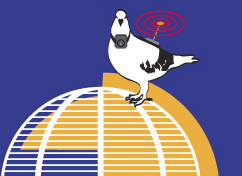|
|
|
|
Pacific Rim artworks
|
Container Culture
|
|
Written by Steve Dietz
|
|
Mar 11, 2006 at 08:59 PM |
Hu Jie Ming Interactive installation: 6 cabin window encased LCD monitors mounted on both sides of the container 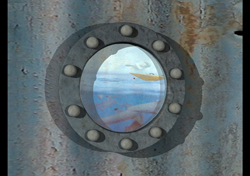 Altitude Zero (2006) project contemplates current global cultural conditions. The interaction between dominant cultural forms and marginal cultures precipitates the emergence of fragmented pockets of variant cultural forms. Often disparaged and in danger of extinction, these edgy cultures are finding their ways for manifestation and representation. Altitude Zero (2006) project contemplates current global cultural conditions. The interaction between dominant cultural forms and marginal cultures precipitates the emergence of fragmented pockets of variant cultural forms. Often disparaged and in danger of extinction, these edgy cultures are finding their ways for manifestation and representation. The installation consists of 6 monitors camouflaged as cabin windows. The video images show ocean waters, drifting materials such as abandoned and polluted objects, symbolizing detachment and alienation from mainstream cultural domains. The objects drift between sea bottom and sea level creating a sense of movement and instability. The drifting materials remind us of the remanents of different cultures and times. Sometimes they clash against the windows, and float away at other times, resonating between the viewers and the objects. Video images are activated according to the audience presence and movement via sensors. |
|
Last Updated ( Apr 12, 2006 at 01:58 PM )
|
|
Read more...
|
|
|
Breadboard Band Comes Alive, The |
|
Pacific Rim artworks
|
|
Feb 12, 2006 at 08:18 AM |
|
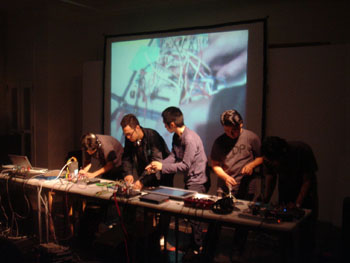
The Breadboard Band is a performing band that uses breadboards made of freely constructed electronic circuits to play music. We produce audio and visual expression through the most minimal, fundamental elements in the form of showing the electronic components of an instrument while directly touching and forming the electronic circuit by hand. The electric signals released from hand-made electronic circuits releases extremely rough and ferocious wave patterns. This performance is based on improvisational interplay, and we pull powerful music into shape through each member's operation, while discovering new sounds by hand.
|
|
Last Updated ( Jun 06, 2006 at 03:35 PM )
|
|
Read more...
|
|
|
Calling for Ba Ba (Mrs. Ba) |
|
Pacific Rim artworks
|
|
Feb 12, 2006 at 08:01 AM |
|
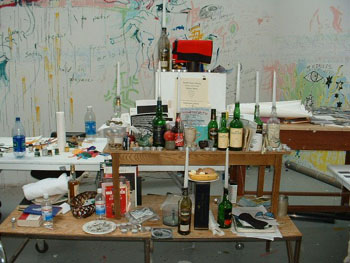
I hope to collect and compare anecdotes of Mrs. Ba from the Vietnamese diaspora in Vancouver and San Jose and transcribe these oral tales to one cohesive history in Vietnamese and English. This record will be a part of the shrines/installations to be installed in Vietnamese noodle restaurants in San Jose.
|
|
Last Updated ( Jul 08, 2006 at 04:24 PM )
|
|
Read more...
|
|
|
Pacific Rim artworks
|
|
Feb 12, 2006 at 06:53 AM |
|
To save people time in the search for interesting clouds, a computer watches the sky all day, every day. Viewers can interact with the computer via the Internet. It establishes individual relationships with each person, developing an idea of the kinds of clouds they like. When they return to the site they are shown the clouds that have passed that would have been their favourites. Their reactions help refine the computer's idea of their taste. It will also show the greatest clouds by popular opinion.
The computer and camera will be in Wellington, New Zealand.
|
|
Last Updated ( Apr 12, 2006 at 01:32 PM )
|
|
Read more...
|
|
|
Container Culture
|
|
Written by Steve Dietz
|
|
Mar 11, 2006 at 08:44 PM |
Xing DanWen Slide projection and one large pile of shredded photographs scattered on the floor
Part of Container Culture (Beijing)
Curated by Zhang Ga 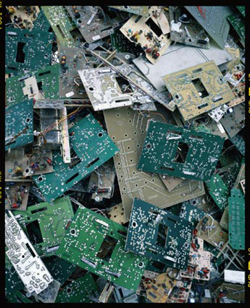 Xing DanWen seeks to sketch a visual representation of modernity in the 21st century. She carefully chooses direct and intimate moments to portray the objects that she finds. Since the summer of 2002, she has traveled several times to South China's Guangdong Province, one of the most developed areas in the country. Along the coast, more than 100,000 people from Guangdong and migrant workers from Western China make their living by recycling piles of computer and electronic trash, operating in rough environment and social conditions. This huge amount of e-trash is shipped from industrialized countries - Japan, South Korea and mostly from the United States, and dumped here. Xing DanWen seeks to sketch a visual representation of modernity in the 21st century. She carefully chooses direct and intimate moments to portray the objects that she finds. Since the summer of 2002, she has traveled several times to South China's Guangdong Province, one of the most developed areas in the country. Along the coast, more than 100,000 people from Guangdong and migrant workers from Western China make their living by recycling piles of computer and electronic trash, operating in rough environment and social conditions. This huge amount of e-trash is shipped from industrialized countries - Japan, South Korea and mostly from the United States, and dumped here. We are in an information and communication era, and rely extensively on these high-tech facilities for our modern life. These machines become deeply rooted in our daily activities, replacing the old ways of doing things. Millions of newly purchased products follow on millions of trashed ones. Confronted with vast piles of dead and deconstructed machines, the overwhelming number of cords, wires, chips and parts, with the clear indication of the company logos, model numbers and even individual employees, This deeply shocked Xing Danwen Modernization and globalization shape urban development. In China, she has experienced and witnessed the changes that have taken place under the influence of Western modernity. These changes have contributed to a strong and powerful push for development in China, but at the same time they have led to major environmental problems and social inequality in remote corners of China. |
|
Last Updated ( Apr 12, 2006 at 01:58 PM )
|
|
Read more...
|
|
|
Container Culture
|
|
Written by Steve Dietz
|
|
Mar 11, 2006 at 09:18 PM |
Huang Shi Interactive installation, 5 glass bottles, mp3 players/recorders, speakers and microphones, processors, batteries
Part of the exhibition Container Culture (Beijing)
Curated by Zhang Ga 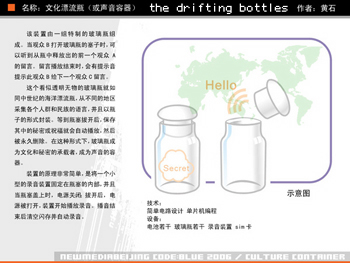 In the middle ages, drift bottles were one of the few means for sailors to communicate with others in the open seas. Notes / messages sealed in the bottles often carried important information or heartfelt blessings. It would be a great surprise for a mediaeval sailor to find a drift bottle likely from some unknown destinations. Mysterious, incidental, and expectant, drift bottle can be seen as a symbol of maritime cross-culture exchange. Today, cell phone, internet and television are rapidly changing our way of communication. Anyone could easily connect with others by simply punching some buttons. High technology is a double-edged sword not only facilitating our daily communication but also eliminating the joy of intimacy and surprise once enjoyed by many. |
|
Last Updated ( Apr 12, 2006 at 01:57 PM )
|
|
Read more...
|
|
|
Pacific Rim artworks
|
|
Mar 15, 2006 at 10:34 AM |
|
Ethermapping explores the electromagnetic dimensions of the landscape - the flow of radio waves forming the ‘radio atmosphere’ within which we live. As human and economic life concentrates in cities, so do radio waves, intensifying in areas of economic activity.
|
|
Last Updated ( Apr 12, 2006 at 01:32 PM )
|
|
Read more...
|
|
|
Pacific Rim artworks
|
|
Feb 12, 2006 at 08:28 AM |
|
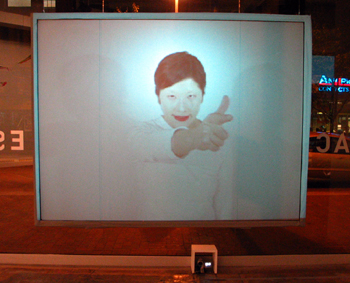
A video character is projected on the bright white wall in an isolated room. Holding a “finger-gun”, she is staring at the audience. Through visual computerization, her finger-gun will follow the motion of the audience in response to their spatial occupation inside the room. The size of the video character will change in relations to the proximity between the audience and the character: the closer the distance between them, the bigger the video character. If the audience stays completely still for more than 7 seconds, she will “shoot” at them, as well as herself in the virtual space. Nobody is hurt in the end but herself. The magic of montage becomes a tragic representation through visual and audio effects.
|
|
Last Updated ( Apr 12, 2006 at 01:33 PM )
|
|
Read more...
|
|
|
Pacific Rim artworks
|
|
Jan 01, 2006 at 04:02 PM |
|
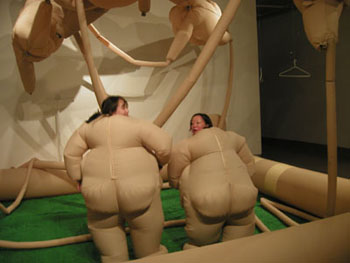
Ho Fatso is an interactive installation consisting of inflatable fat suits and a wrestling ring controlled by motion sensors. Made of rip-stop nylon, powerful leaf blowers and motion detectors, audience members are encouraged to don the fat suits, enter the ring and wrestle each other. Any action in the vicinity of the installation initiates the inflation of the suits and the wrestling ring. If there is no one in the ring, the blowers stop and the installation slowly deflates. Each of the suits are linked to the blowers through and intricate umbilical cord-like system. |
|
Last Updated ( Jun 12, 2006 at 11:29 AM )
|
|
Read more...
|
|
|
Interrogating the Invisible |
|
Pacific Rim artworks
|
|
Feb 12, 2006 at 07:18 AM |
|

The Leistavian FBI will create an online survey form which allows for the input of multiple cultural identifications. Those that register one main cultural identity will become a control group, while those that register two or more cultural identifications, in particular those with at least one affiliation to a Pacific Rim nation, will be the target group. The form also collects information on attitudes to cultural identification issues. The data will be presented online as statistical summaries, in the installation area as large scale vinyl imagery (non-rectangular, adhered directly to wall, where image component size registers survey responses), and as a projected animation which registers change in survey responses.
|
|
Last Updated ( Jul 17, 2006 at 03:37 PM )
|
|
Read more...
|
|
|
Container Culture
|
|
Written by Steve Dietz
|
|
Feb 08, 2006 at 05:46 PM |
![in[]ex in[]ex](../../../../images/artwork/inex_logo.gif) Artists Kate Armstrong, Bobbi Kozinuk, M. Simon Levin, Laurie Long, Leonard Paul, Manual Pina, Jean Routhier
Curator Alice Ming Wai Jim.
IN[ ]EX, an interactive, city-wide collaborative media art project involving a shipping container and thousand of smaller modules. IN[ ]EX is a distributed audio sculpture in which thousands of wooden blocks with embedded technology are released into the city to engage the public as active agents. IN[ ]EX invites audience activity, movement and interaction, as well as engages with the larger urban context as the blocks are dispersed throughout the city and culture in general. |
|
Last Updated ( Jul 07, 2006 at 02:45 PM )
|
|
Read more...
|
|
|
Pacific Rim artworks
|
|
Jan 01, 2006 at 04:24 PM |
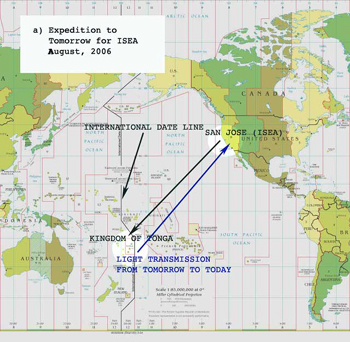 Light from Tomorrow centres on an expedition to The Kingdom of Tonga, where tomorrow’s outdoor light-readings are broadcast in close to real time through The International Dateline to today; specifically to a lightbox installed in the San Jose Museum of Art in California as part of the group exhibition Edge Conditions. The lightbox in San Jose responds to fluctuations and broader changes in outdoor light conditions in Nuku'alofa offering a tangible connection to the future, a window quite literally onto tomorrow. |
|
Last Updated ( Aug 02, 2006 at 12:58 PM )
|
|
Read more...
|
|
|
Moveable Types and Instant Spaces / Love Virus |
|
Container Culture
|
|
Written by Michela Pilo
|
|
Jul 19, 2006 at 12:38 PM |
Moveable Types and Instant Spaces Artists: Taeyoon Choi, Tellef Tellefson and Cheon Pyo Lee Moveable Types and Instant Spaces explores how temporary types of architecture can define an experience, and alternatively how social or personal actions and objects can change the perception of a space Lightweight materials are used, suggesting to the viewer that architecture is a concept rather than a reality and that it has less importance than that which it contains. “Pod types” are lightweight architectures that play off of existing sites. They human in scale and can be placed temporarily within the landscape. Working off the idea of wearable architecture, these small types strive to create personal space in the public realm. Each pod type derives its function and a minimum of form from the objects it contains, and in exchange the function of the objects is altered by the architecture. |
|
Read more...
|
|
|
Pacific Rim artworks
|
|
Feb 12, 2006 at 07:44 AM |
|
![other[wize] 9 stories](../../../../images/artwork/9176jennyfraser.jpg)
The interactive other[wize] stories will be imparted through the use of still images, video, animation, audio, and text - including Yugambeh language. The 'objects' are representative of important people or events and they transport the viewer to a story about someone from the past. The 'stories' will also include animals, landscapes, seascapes and others.
Events evolve in a non-linear way, grasping at the unknown, not sure of what will be found or how it relates to other information, until perhaps another time. This concept reflects how many Aboriginal people experience family histories. The viewer has the opportunity to experience a similar 'fragmentation' of history and they might think about their own relationship to place and times.
|
|
Last Updated ( Apr 12, 2006 at 01:34 PM )
|
|
Read more...
|
|
|
Container Culture
|
|
Written by Steve Dietz
|
|
Apr 01, 2006 at 04:41 PM |
Container Culture: Auckland 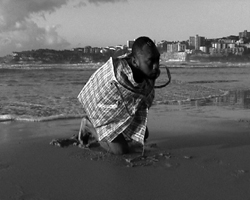 Pacific Washup was produced during a short collaborative residency at Performance Space in Sydney, 2003. The three collaborating artists had never met before and had no prior knowledge of each others practice. Through the first days of the residency we engaged in dialogue about who we were, where we came from, and why we had been brought together. This was a predominantly cultural discussion of family and place. We had commonalities through our Polynesian heritage and links to the Pacific Islands and New Zealand. However, our contrasting 'uncommonalities' regarding the geographic and cultural positions we inhabit as indigenous people of the Pacific, as migrants or non-migrants, became significant too. Pacific Washup was produced during a short collaborative residency at Performance Space in Sydney, 2003. The three collaborating artists had never met before and had no prior knowledge of each others practice. Through the first days of the residency we engaged in dialogue about who we were, where we came from, and why we had been brought together. This was a predominantly cultural discussion of family and place. We had commonalities through our Polynesian heritage and links to the Pacific Islands and New Zealand. However, our contrasting 'uncommonalities' regarding the geographic and cultural positions we inhabit as indigenous people of the Pacific, as migrants or non-migrants, became significant too. |
|
Last Updated ( Apr 24, 2006 at 10:46 AM )
|
|
Read more...
|
|
|
Container Culture
|
|
Written by Steve Dietz
|
|
Apr 01, 2006 at 02:05 PM |
Annie On Ni Wan Hong Kong Container “The phenakistoscope (also spelled phenakistiscope) was an early animation device, the predecessor to the zoetrope. . . . The word "phenakistoscope" comes from Greek roots meaning "deceiving viewer"."
Wikipedia Phenakistoscape is a kinetic interface through, which is an experiment in the metaphysics of moving image projection and an exploration of the language of mobile projection, with particular emphasis upon on its distinctive temporal and spatial modalities. 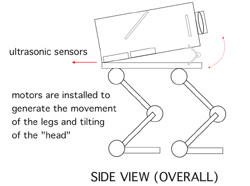 Phenakistoscape uses a custom-made biped robotic video projector. The camera movements of the moving images take control of the movement of the robotic projector, which pans to left when there is a pan to right shot in the video and tilts up when there is a tilt down shot. The robotic video projector walks randomly with slow speed inside the container space as well. Phenakistoscape uses a custom-made biped robotic video projector. The camera movements of the moving images take control of the movement of the robotic projector, which pans to left when there is a pan to right shot in the video and tilts up when there is a tilt down shot. The robotic video projector walks randomly with slow speed inside the container space as well. With Phenakistoscape, a mechanical algorithmic approach to video projection is introduced as a language of mobile video projection. New methods for extending the practice of moving image space within physical space are presented as a dynamic and unexpected labyrinth that reconstructs the architecture of time and space. Phenakistoscape presents an entirely distinct scheme for unfolding the profound poetry encoded in cinematic space, and hence it effects the creation of an exceptional perception of moving images. |
|
Last Updated ( Apr 01, 2006 at 03:49 PM )
|
|
Read more...
|
|
|
Container Culture
|
|
Written by Steve Dietz
|
|
Apr 01, 2006 at 05:05 PM |
Rachael Rakena Container Culture: Auckland rere ... flow, fly, be carried by the wind, sail, rush, flee, escape, rise, leap, . . .
hiko ... move at random or irregular, lightning, electric, . .
whakapapa ... layering, genealogy 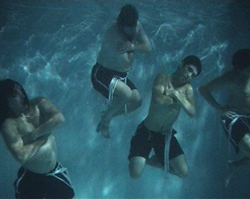 An email announcing the arrival of a newborn child bears the same face as an email expressing sympathy at the loss of a loved one. The digital text of the email and its aesthetic of pixels create the new patterns for the wharenui (meeting house) of cyberspace in which our indigenous community often meet. This work explores the communication using excerpts of real emails circulating within a Ngai Tahu community (an indigenous tribal group from the South Island of New Zealand). An email announcing the arrival of a newborn child bears the same face as an email expressing sympathy at the loss of a loved one. The digital text of the email and its aesthetic of pixels create the new patterns for the wharenui (meeting house) of cyberspace in which our indigenous community often meet. This work explores the communication using excerpts of real emails circulating within a Ngai Tahu community (an indigenous tribal group from the South Island of New Zealand). Rerehiko becomes a cyberspace whare whakairo (decorated meeting house). The community float through their own email text performing narratives that evoke their many collective concerns in the new century. Linking to creation stories through the construction of a new realm of the cosmos, the cyberspace, in which this indigenous group already resides, an echo of the Pacific Ocean crossed by our ancestors. |
|
Last Updated ( Apr 01, 2006 at 05:12 PM )
|
|
Read more...
|
|
|
Container Culture
|
|
Written by Steve Dietz
|
|
Apr 01, 2006 at 11:33 PM |
Jin Jiangbo Container Culture: Beijing 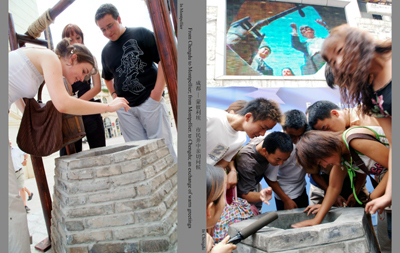 The third eye perceives the earth. The third eye perceives the world, The third eye perceives you and me, And the third eye perceives our mind. Imagination from the far west and far east of the earth. The open of this third eye shall let the imagination hold free and fair dialogues, and through the channel, it shall inspire hope for the people from these two cities. The third eye crosses space and beyond. |
|
|
Travels of Mariko Horo, The |
|
Pacific Rim artworks
|
|
Jan 01, 2006 at 04:42 PM |
|
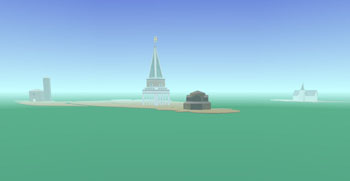
Sometime between the 12th and the 22nd centuries Mariko Hōrō, Mariko the Wanderer, journeys westward from Japan in search of the Buddhist Paradise floating in the Western Seas. She does find Paradise, but finds also a chilling, darker side to the West, an island where lost souls are held in an eternal Limbo. She encapsulates her impressions of the places she visits in a series of 3D virtual worlds and invites you to see the West through her eyes. Supported by a Japan Foundation Fellowship at the Kyoto Art Center, and a Fellowship at the Center for Advanced Visual Studies, MIT. |
|
Last Updated ( Apr 12, 2006 at 01:34 PM )
|
|
Read more...
|
|
|
Uncle Tasman: The Trembling Current that Scars the Earth |
|
Pacific Rim artworks
|
|
Written by Administrator
|
|
Feb 12, 2006 at 08:23 AM |
Uncle Tasman
The trembling current that scars the earth
Natalie Robertson
“Whatu ngarongaro he tangata, toitu he whenua
Yellow-grey fumaroles hiss steamily, venting their pleasure, a marine volcano island named Whakaari, flirting with her land born admirer, Putauaki.
Tarawera is aghast when her man leaves her side and she bursts into tears, flowing and filling his footsteps as Putauaki heads towards the sea.
Putauaki however is slowed by a young son, Ko Putauaki, pleading his destination – daylight breaks and the father is frozen in shame as the shadows chase from his midnight fantasy.
Mountains move in Maori mythology, as they do in real life, falling seismically in love, having children, splitting up, running off with new lovers, falling silent and, sometimes, erupting volcanically.
Natalie Robertson taps a stick into the ground, testing her way forward trying to find solid ground between pools of steaming hot water and sulphuric yellow crusts of earth.
On lands bordering the ancient pa Waitahanui, Robertson sets up a camera.
In front of her, the mountain and a paper mill worth $300 million a year in exports.
She begins recording.
Mist and steam waft evocative. Power poles ghost into view, and out again; a shadowy mountain looms, ponders, and wafts away again, an extended moment captured for larger than life projection onto walls.
Uncertainty, seemingly, whether mist is man or mystic made.
Born at the foot of Putauaki maunga, Robertson has returned to film in her hometown Kawerau, using local knowledge to access the site, past the private property signs, down a gravel track, wending curvy parallel with the Tarawera River.
Robertson records and ripples spread rapid across the surface of water, bigger than a pond, not really a lake. Behind Robertson, over a hill, blocked by card swipe access and guarded by security workers, lies what was once Lake Rotoitipaku, out of sight from public eyes.
“That’s what I having been trying to tell you – Lake Rotoitipaku doesn’t exist anymore. ”
For generations a naturally heated “food basket” and geothermal “spa pool” for Ngati Tuwharetoa ki Kawerau, the lake is now full, dry and clogged with tens of thousands of truckloads of industrial sludge, a lake-no-more.
More importantly, the dump is next to an urupa – a cemetery, a sacred site – and birthplace of renowned leader and paramount chief, Tuwharetoa.
“Without local knowledge, no one would even know this was once Lake Rotoitipaku,” says Robertson, looking at satellite photos. There are bulldozer furrows, rugby fields long.
New maps have already been printed giving a smaller, nearby lake the same name. Supposedly, this replaces the old name, Fox’s Pond, a nickname applied by company officials and, apparently, picked up by cartographers.
But, digging through documents in Kawerau, Robertson finds a map dating back to 1883, showing true location of the lake, along with stories of its bubbling mineral waters fat with eels, and water vegetables – kumara would grow in weeks rather than months.
But, two maps? How can there be double truths, two lakes with the same name?
In fact, there are many maps, indeed layers of maps. Historic maps, tablecloth maps, and souvenir map scarves. Robertson has made mapping systems a central theme within her artwork, photographing road signs, place names, weather elements and referencing Maori oral maps.
Signposts of a new mapping system, an inferior two dimensional model compared with what Robertson prefers to describe as “cosmology” – a swirling universe that places the land central to Maori existence, calling to mind that the most important thing is not only people, people, people.
It is also whenua, the land.
Papatuanuku. Mother Earth.
“Whatu ngarongaro he tangata, toitu he whenua” – People pass away, but the land remains.
Three monitors greet visitors: one for each of the three mountains, Putauaki, Tarawera and Whakaari. A sulphuric fumerole hisses. A tauparapara, a chant begins, voice of elder Te Haukakawa Te Rire. A lament for lost lands and waterways echoes back. Robertson provides offstage commentary with a drive through Kawerau, recounting young lives lost to cancer, the names accumulating over the years. This one, then that one, encircling the town.
As a photographer and now videographer, Robertson is not trying to capture and expose environmental abuses, but to record the few remnants remaining of what once was.
Left unspoken is a warning that land remains volatile, volcanic spasms an intergenerational reality recorded by what some call Maori mythology.
Like a three dimensional iMax of the mind, Maori mythology consists of a cosmos growing from countless centuries of Polynesian navigation, leading to landfall with star point accuracy. Mental maps do not stop at the beach, they help triangulate natural features like mountains, from different viewpoints, and in real-time as well, under mist or moon.
Perhaps there were times earlier, when land was ample, people few, and feats like securing kumara from the Americas were commonplace. In Kawerau, those times are long gone and mists come complete with chlorine gas sirens.
Researching, Robertson reviews more than 20 boxes of documents, gathered by multiple critics and challengers like Greenpeace, in stories of a paper mill that read like environmental Pulp Fiction. Bizarre characters, addiction to toxic substance abuse, random death. Some may remember Samuel L. Jackson psyching himself up for strife.
“… And I will strike down upon thee with great vengeance and furious anger those who would attempt to poison and destroy my brothers…”
So far, however, evidence that proves poisoning remains buried in boxes, stymied by special dispensations, lax bureaucrats, and allegedly vested interests stretching back half a century.
In 1954, Government passed the Tasman Pulp and Paper Company Enabling Act, allowing all effluent from the new Kawerau mill to be discharged into the Tarawera River. Parliamentary records, Hansard, show there was debate about effects on farmers downstream using the river for stock watering. But discharges were described by the government of the day as “so slight as to be almost unnoticeable”.
Exemption of the company from prosecution or individual action for damages was regarded as necessary in case “some crank gets a bee in his bonnet” as any existing environmentalists were regarded in the post-war peace boom.
One relatively minor example is asbestos – ripped out of the mill to protect the health of workers but then dumped on Maori lease lands.
Someone else’s problem.
Not for “Uncle” Tasman, the nickname wry commentary about the town benefactor, provider of jobs and contracts, enough income to keep a town of about 8,000 going for half a century, enough power to ensure critics are blacklisted.
Black also features in another local nickname – “The Black Drain” –colour of the last stretch of river below the mill to the sea.
New roads were built to truck waste away from the mill, liquid waste poured down a spillway, solid waste dumped straight into Rotoitipaku.
“My cousins and I went to have a look at the spill way,” recalls Wayne Peters in evidence to the Central North Island Inquiry at the Waitangi Tribunal in 2005.
“The sludge was slowly moving into the lake from the ngawha (hotpool) end. Little did we know this was the beginning of the end to our playground and foodbasket. Sadness filled our minds. Then anger took over, we knew what was happening was wrong. We lifted a big boulder from the side of the road and smashed the spillway. The workers fixed it up, and we smashed it again.
“In time we came to realise that Rotoitipaku was gone FOREVER,” states Peters, the last word capitalised in submissions to the tribunal.
In just three decades the lake is full, promises to keep water flowing to a depth of “at least six inches” long forgotten by Tasman.
“A visit to the area today leaves me wondering how anyone could take a piece of paradise and turn it into hell. There is a stench that carries across the river to the homes of my aunties and uncles in Onepu; Waitahanui is surrounded by sludge and a pond of black water,” says Clem Park, a resident. He remembers swimming in Rotoitipaku as a child.
“Many times I asked Uncle Bunny why they allowed these things to happen. All he would say was they could do nothing.” Fast forward to the government of today.
Today an estimated 100,000 truckloads of ‘solid’ industrial waste dumped into a lake that is no more, while there is enough annual liquid waste to rival the output of Auckland.
Greenpeace reckons Kawerau, one of the largest geothermal fields in the country, is also one of the worst toxic areas in the country. People Poisoned Daily is the name of one Greenpeace campaign, with an online exhibit of people affected by milling.
Tairua Whakaruru has been a health officer for Ngati Tuwharetoa over the last seven years. He sits outside the mainstream health service, reporting on years, decades of requests for comprehensive surveys of the Kawerau population and nearby environs.
“There have been no reports done on health in the area in regards to the Tarawera River or the discharge into the air and onto the land. All these issues are of valid concerns to the iwi along the river,” the site quotes Tairua Whakaruru as saying.
Greenpeace adds to his comment. “Tairua would like to see Maori organisations do the health report on their own people who are effected by the discharge. This is also about the pain and effect this has had on the iwi and is still having.”
“Many of the old people have gone to their graves fighting this issue.”
As Robertson finishes her artwork, the OECD issues a follow-up report to its original environmental review in 1997.
“The whole area of waste management does not seem to be a priority for the Government,” states the OECD as part of its peer review process, in this case for the environment.
“As a result, waste issues are poorly analysed and, in many cases, disregarded,” reads the report. Thirty different first world countries sat on the review panel.
Back in Kawerau, ghosts of Lake Rotoitipaku stir.
A lifetime away from naming and shaming at the geopolitical level, Wayne Peters eye witnessed nature reacting to Uncle Tasman’s toxic love: “I can still remember the tuna (eel) on the road at Rotoroa trying to escape the paru (sludge) – it was as though they knew too, the lake and river was polluted, [so] we will die in the afternoon sun. Let us be an example of what pollution can do.
But, alas, it fell on blind eyes and deaf ears.”
Leases expire in 2013. What families get back is an area deeply contaminated with decades of industrial waste, clean up costs estimated in billions by Greenpeace workers.
By comparison, government recently advertised for a contamination site coordinator – to head a fund of just $3 million – for the whole country.
Reality behind political rhetoric claiming the environment as “cornerstone” to sustainable development seems alarmingly empty for a country dependent on exports and tourism being worth billions to the economy.
“I want this work to contribute to demystifying claims to New Zealand being clean, green and 100% natural,” says Robertson, aiming an artistic assault at Kiwi propaganda.
Much more could be at stake than a few billion dollars. Robertson seeks to remind corporates and locals alike of Ruaumoko - God of earthquakes and volcanoes, – and Papatuanuku’s unborn child, stirring and kicking, eager to live up to the promise of its name signifying an earthquake scar, a reminder that Aotearoa sits balanced along the Pacific “rim of fire” with potential for sludge from deeply toxic dumping sites to be scattered far and wide from what is known as the Taupo volcanic plateau if more eruptions were to occur.
As a daughter of Maui, Robertson contests “the way things are” recording what is left of a natural land, Maori cosmology now enveloping Western technology.
"It's my way of honouring those who have died," Robertson continues. "Of making some sense of why so many friends and people I know from Kawerau died of cancer so young. As the list grows, so does my superstition. Is it me? Or something in the air?"
Interviewing local Waitangi Tribunal claimant Tomoirangi Fox, she asks him what was the one thing he wants people to think about, and the answer, as always with people of the land, is practical.
“Who,” Fox asks, “is going to clean it up?”
A question that lays a challenge to government promises for a “triple bottom line” – one that includes the environment –volcanic mountains hopefully remaining patient with the pace of Pakeha justice.
Jason Brown, April 2007
Edited Natalie Robertson, June 2008
LINKS
http://www.natalierobertson.com/uncletasman/
"Are We There Yet?": Natalie Robertson's Road Signs
http://01sj.org
|
|
Last Updated ( Jul 15, 2008 at 04:55 PM )
|
|
|
Container Culture
|
|
Written by Steve Dietz
|
|
Mar 11, 2006 at 08:02 PM |
Xu Bing Installation with artifacts, neon arrow signs, display pedestal
Part of the exhibition Container Culture
Curated by Zhang Ga 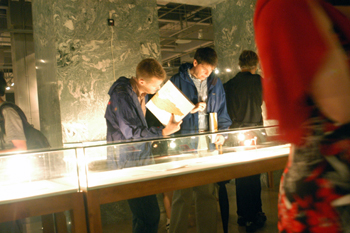 Zhong Chen (Prophecy) is one component of the site specific Tobacco Project. This part of the installation consists of a display pedestal encased with original accounting paperwork, bank records, receipts and other historical artifacts that document the business transactions of the British American Tobacco Company in China it its formative days, the display also contains the artist's personal financial transaction record with the Duke Foundation during the creation of the Tobacco Project in 2000. The project traces the trajectory of the multinational tobacco company's expansion into the world's most populous country and urges us to reflect on China's modern and contemporary experience as a marketplace as well as her interaction with global economy, implicitly invoking its multiple interpretations. Xu Bing's Zhong Chen realizes its experimental quality by engaging art in a new kind of dialogue with commercial culture and international relations. The work is neither a representation of observed reality nor an installation of ready-made materials. Rather, it remains in close contact with reality while transforming reality. It would be futile to ask whether it is a "work of art" because Xu Bing did not make it as such, and because its meaning can only be grasped when it is approached as part of a broad, complex social and political process. |
|
Last Updated ( Apr 12, 2006 at 01:59 PM )
|
|
Read more...
|
|
|
|
| |
|
|
|
